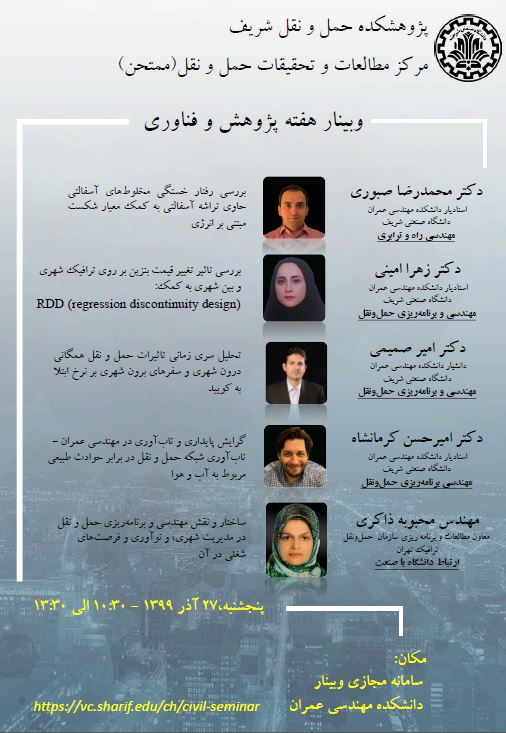استفاده از فراگیری ماشین در مهندسی راه
Application of Machine Learning in Pavement Engineering
مهندس حامد مجیدی فرد، دانشجوی دکترای دانشگاه دانشگاه میزوری، کلمبیا، آمریکا
چهارشنبه 17 دی 1399، ساعت 15:00 تا 16:30
لینک ورود:
https://vc.sharif.edu/ch/civil-seminar
نحوه ورود: آزاد، با درج نام خود، بدون نیاز به پسورد، با گزینه “میهمان” وارد شوید.
چکیده
اخیرا استفاده از فراگیری ماشین در حوزه مهندسی راه توجه بسیاری از محققین راه سازی را جذب کرده است. در این پژوهش، یک ابزار تخمینی برای ارزیابی عملکرد مخلوط آسفالتی در دمای پایین و بالا طراحی شده است. این ابزار بر پایه دو مدل مجزا برای آزمون شکست انرژی DC(T) و آزمون چرخ هامبورگ (Hamburg Wheel Load Track) ساخته شده است. برای آزمون شکست انرژی، از ژنتیک الگوریتم برای ساخت مدل تخمینی استفاده شد و برای مدل شیارشدگی هامبورگ از الگوریتم شبکه عصبی برای آموزش دادهها استفاده شد. این مدل ها براساس یک پایگاه دادهای متشکل از نتایج این دو آزمون بدست آمده اند. این ابزار قابلیت استفاده برای پیش طراحی مخلوط آسفالتی به منظور دستیابی به بهترین عملکرد شیارشدگی و ترک خوردگی را دارد. این مدل ها براساس پارامتر های ورودی مختلفی از قبیل دمای عملکردی قیر، نوع مخلوط آسفالتی، اندازه سنگدانه، درصد کل قیر، درصد قیر بازیافتی، دمای انجام آزمون و تعداد سیکل بنا شدهاند. استفاده از اینگونه مدلهای تخمینی، تعداد آزمایشها را محدود ساخته و زمان و هزینه بسیاری را در فرآیند طراحی صرفهجویی میکند.
همچنین، از فراگیری ماشین برای ساخت یک سیستم هوشمند اتوماتیک ارزیابی خرابی جاده استفاده شد. به صورت معمول، بازرسی خرابیهای جاده با استفاده از ماشینهای پیچیده جمع آوری اطلاعات یا ارزیابی چشمی در محل انجام میشود. که نه تنها هزینهبر، بلکه حضور ارزیاب در محل و یا اختلال ترافیکی باعث کاهش ایمنی میشود. ارزیابی اتوماتیک خرابی جاده با استفاده از تکنیکهای پردازش تصویر باعث صرفه جویی در وقت و افزایش ایمنی میشود. در این پژوهش، از یک مدلU-net برای تشخیص شدت خرابیها استفاده شد. با ترکیب دو مدل Unet و YOLO، یک مدل هیبردی ساخته شده که قابلیت تشخیص همزمان نوع و شدت خرابی را دارد. این ابزار امکان بررسی وضعیت جاده ها در طول عمر جادهها را دارد که برای تصمیم سازی صحیح در مدیریت نگهداری بسیار مفید خواهد بود.
Biography
Hamed Majidifard is a PhD candidate in Civil Engineering at the University of Missouri. He conferred his M.Sc. degree from Sharif University of Technology. His research primarily focuses on implementing machine learning techniques to predict the performance of asphalt mixtures and pavement conditions, advancement of mixture sustainability, and promoting durability of asphalt mixtures (crack resistance, balanced mix design). Additionally, he has carried out multiple research studies with the focus on devising a programming approach to predict the low and high-temperature performance of asphalt mixtures using machine learning techniques. This tool can be used for pre-design purposes to design an asphalt mixture with balanced performance in rutting and cracking. Finally, his primary research employs deep learning techniques to devise an automatic pavement monitoring system, which allows for effective assessment of the pavement condition using pictures and videos instead of manual field observation and evaluation. He has published 10+ journal and conference papers. He has also peer-reviewed 20+ articles for Road and Material Pavement Design, Construction Building Material, and Transportation Research Record journals.

